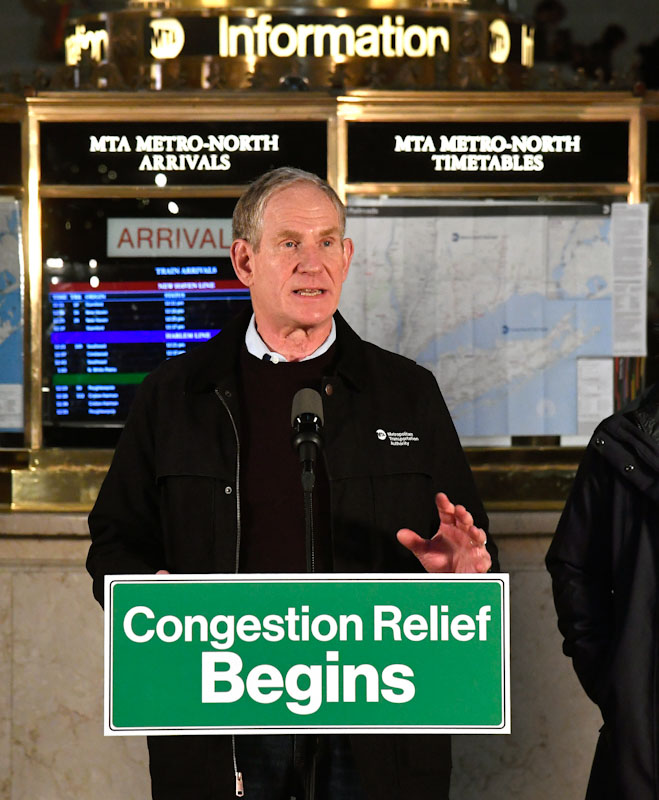With Congestion Tolls Underway, State Officials Now Face Massive MTA Capital Program Deficit
By JOHN JORDAN – January 2025
NEW YORK—Will the new revenues streaming from congestion tolling infuse public coffers with enough money to fill the budget deficit in the MTA’s capital program—estimated at $33 billion?
If that question isn’t enough to give politicians and transit leaders pause, budget troubles were further exacerbated when, on Christmas Eve, Senate Majority Leader Andrea Stewart Cousins and Assembly Leader Carl Heastie rejected the MTA’s $65.4-billion capital plan. Two days before the plan would have lapsed into approval, the two leaders sent MTA Chair and CEO Janno Lieber the bad news: “The proposed program currently faces a significant funding deficit, generally recognized to be at least $33 billion of the $65 billion proposed total subject to CPRB approval, which is a specific concern that needs to be addressed before we can approve the program.”
New York State Comptroller Thomas DiNapoli on Jan. 7 echoed the concerns of Sen. Stewart Cousins and Assemblyman Heastie, stating that the MTA will be facing financial challenges even with congestion pricing in place. In an interview on Spectrum News’ “Mornings on 1,” he said the MTA capital program’s funding gap is $33 billion.
“The congestion pricing is going to leverage money for bonding to deal with the current capital plan (2025-2029). But the new one is also up in the air because the capital review board rejected it,” he said.
MTA leadership said if they had to cut, the first thing that would go is expansion projects, according to a NY1.com report.
The MTA activated the congestion pricing program, charging a toll for motorists to enter Manhattan below 60th Street, formally known as the Central Business District (CBD)—now also referred to as the Congestion Relief Zone (CRZ)—to reduce traffic congestion, improve air quality and raise needed revenue to improve public transportation. The program launched Sunday morning, Jan. 5, at 12:00:01 a.m. charges for automobile drivers using E-ZPass, a peak toll for vehicles entering the CRZ at $9.00 and an overnight rate of $2.25.

MTA Chair and CEO Janno Lieber secured his legacy as the first transit leader to bring congestion tolling to an urban business district in the U.S. when the Central Business District tolling program was launched on Jan. 5. Now the MTA boss—call him Robert Moses Power Broker 2.0—must wrestle with Albany over the Authority’s next capital plan.
“The Congestion Relief Zone has been in operation since midnight – 1,400 cameras, over 110 detection points, over 800 signs and 400 lanes of traffic and it’s all gone smoothly,” said Mr. Lieber. “We want to encourage trucks to do more deliveries at night, we want improvements to vehicle speeds especially for buses, we want to make sure that emergency response vehicles can get where they are going faster, and I hope drivers will take another look at the speed and convenience of mass transit.”
MTA Construction & Development President Jamie Torres-Springer added, “Thanks to congestion pricing, MTA Construction & Development will undertake a generational investment to transform public transit in New York. We’re ready to get these projects started and we’re ready to deliver them better, faster and cheaper than ever before.”
The plan earmarks 80% of the revenue generated for capital improvements on NYC Subways and Buses, 10% to Metro-North Railroad and 10% percent to the Long Island Rail Road.
A phased-in toll plan that starts at 40% of the eventual toll enables the MTA to issue $15 billion in bonds to fund the MTA’s 2020-2024 Capital Plan and advance critical capital projects. After the pause on congestion pricing was lifted, the MTA exercised the option to purchase 265 zero-emission buses on Nov. 27.
The program provides $335 million in mitigation programs, including $148 million in regional mitigation measures and monitoring of traffic, air quality, and transit station elements, and $82 million for the Low-Income Discount Plan. In addition, the program also committed $100 million in funding for place-based mitigation to 13 environmental justice communities in the Bronx, Brooklyn, Upper Manhattan and New Jersey.
